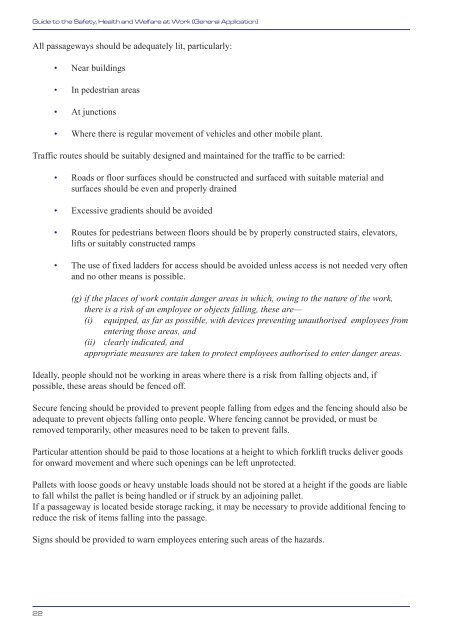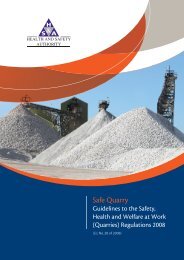Guide to the Safety, Health and Welfare at Work (General Application)
Guide to the Safety, Health and Welfare at Work (General Application)
Guide to the Safety, Health and Welfare at Work (General Application)
You also want an ePaper? Increase the reach of your titles
YUMPU automatically turns print PDFs into web optimized ePapers that Google loves.
<strong>Guide</strong> <strong>to</strong> <strong>the</strong> <strong>Safety</strong>, <strong>Health</strong> <strong>and</strong> <strong>Welfare</strong> <strong>at</strong> <strong>Work</strong> (<strong>General</strong> Applic<strong>at</strong>ion)<br />
All passageways should be adequ<strong>at</strong>ely lit, particularly:<br />
• Near buildings<br />
• In pedestrian areas<br />
• At junctions<br />
• Where <strong>the</strong>re is regular movement of vehicles <strong>and</strong> o<strong>the</strong>r mobile plant.<br />
Traffic routes should be suitably designed <strong>and</strong> maintained for <strong>the</strong> traffic <strong>to</strong> be carried:<br />
• Roads or floor surfaces should be constructed <strong>and</strong> surfaced with suitable m<strong>at</strong>erial <strong>and</strong><br />
surfaces should be even <strong>and</strong> properly drained<br />
• Excessive gradients should be avoided<br />
• Routes for pedestrians between floors should be by properly constructed stairs, eleva<strong>to</strong>rs,<br />
lifts or suitably constructed ramps<br />
• The use of fixed ladders for access should be avoided unless access is not needed very often<br />
<strong>and</strong> no o<strong>the</strong>r means is possible.<br />
(g) if <strong>the</strong> places of work contain danger areas in which, owing <strong>to</strong> <strong>the</strong> n<strong>at</strong>ure of <strong>the</strong> work,<br />
<strong>the</strong>re is a risk of an employee or objects falling, <strong>the</strong>se are—<br />
(i) equipped, as far as possible, with devices preventing unauthorised employees from<br />
entering those areas, <strong>and</strong><br />
(ii) clearly indic<strong>at</strong>ed, <strong>and</strong><br />
appropri<strong>at</strong>e measures are taken <strong>to</strong> protect employees authorised <strong>to</strong> enter danger areas.<br />
Ideally, people should not be working in areas where <strong>the</strong>re is a risk from falling objects <strong>and</strong>, if<br />
possible, <strong>the</strong>se areas should be fenced off.<br />
Secure fencing should be provided <strong>to</strong> prevent people falling from edges <strong>and</strong> <strong>the</strong> fencing should also be<br />
adequ<strong>at</strong>e <strong>to</strong> prevent objects falling on<strong>to</strong> people. Where fencing cannot be provided, or must be<br />
removed temporarily, o<strong>the</strong>r measures need <strong>to</strong> be taken <strong>to</strong> prevent falls.<br />
Particular <strong>at</strong>tention should be paid <strong>to</strong> those loc<strong>at</strong>ions <strong>at</strong> a height <strong>to</strong> which forklift trucks deliver goods<br />
for onward movement <strong>and</strong> where such openings can be left unprotected.<br />
Pallets with loose goods or heavy unstable loads should not be s<strong>to</strong>red <strong>at</strong> a height if <strong>the</strong> goods are liable<br />
<strong>to</strong> fall whilst <strong>the</strong> pallet is being h<strong>and</strong>led or if struck by an adjoining pallet.<br />
If a passageway is loc<strong>at</strong>ed beside s<strong>to</strong>rage racking, it may be necessary <strong>to</strong> provide additional fencing <strong>to</strong><br />
reduce <strong>the</strong> risk of items falling in<strong>to</strong> <strong>the</strong> passage.<br />
Signs should be provided <strong>to</strong> warn employees entering such areas of <strong>the</strong> hazards.<br />
22

















